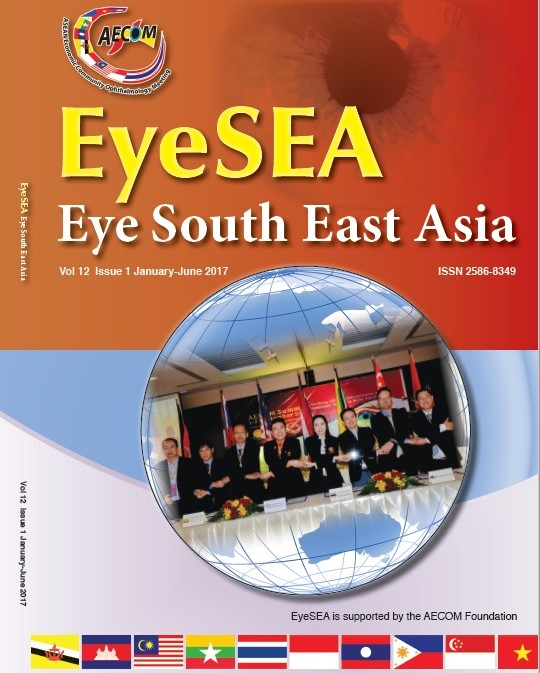Post-operative refraction in the patients with out-of-the-bag intraocular lens implantations
Main Article Content
Abstract
Objective: To study the association between the estimated refraction for in-the-bag intraocular lens (IOL) implants and the post-operative refraction in the patients with out-of-the-bag implants.
Methods: This retrospective study examined medical records of all patients who had undergone complicated cataract surgery with out-of-the-bag IOL implants in Thammasat university hospital from January 1st 2013 to December 31st 2015. We recorded sex, age, diagnosis, type of cataract surgery, type of IOL, implantation position, estimated post-operative refraction for in-the-bag implants and actual post-operative refraction at the 1st and 3rd months. The estimated and the post-operative refraction association was evaluated by simple regression analysis.
Result: We identified 51 patients (51 eyes) who underwent complicated cataract surgery with out-of-the-bag IOL implants; 27 in-the-sulcus implants and 24 sclera-fixed implants. For the in-the-sulcus group, the estimated preoperative refraction was -0.89 to +0.86 D (mean=+0.08, SD ±0.43) and the actual post-operative refractions at the 1st and 3rd months were -3.00 to + 1.50 D (mean= -0.51, SD ±0.99) and -3.25 to +0.50 D (mean= -0.54,SD ±0.95), respectively. The pre- and 3 months postoperative refractions were significantly (p=0.0391) correlated. For the sclera-fixed group, the estimated preoperative refraction was -0.34 to +1.22 D (mean=+0.33, SD ±0.37) and the actual post-operative refraction 1st and 3rd months were -4.00 to +1.00 D (mean= -0.99, SD ±1.31) and -2.75 to +0.75 D (mean= -0.83, SD ±1.06), respectively but there was no significant pre- and post-operative correlation.
Conclusion: Out-of-the-bag IOL implants are associated with postoperative myopic shifts, -0.54D in in-the-sulcus group and -0.83 D in scleral-fixed group. Base on out derived linear regression equation, the IOL power selection for in-the-sulcus implants should be +0.77 to achieve the post-op emmetropia.
Article Details
References
Foster A, Johnson GJ. Magnitude and causes of blindness in the developing world. International ophthalmology. 1990;14(3):135-40.
Resnikoff S, Pascolini D, Etya'ale D, Kocur I, Pararajasegaram R, Pokharel GP, et al. Global data on visual impairment in the year 2002. Bull World Health Organ. 2004;82(11):844-51.
Yospaiboon Y, Yospaiboon K, Ratanapakorn T, Sinawat S, Sanguansak T, Bhoomibunchoo C. Management of cataract in the Thai population. J Med Assoc Thai. 2012;95 Suppl 7:S177-81.
Trinavarat A, Neerucha V. Visual outcome after cataract surgery complicated by posterior capsule rupture. J Med Assoc Thai. 2012;95 Suppl 4:S30-5.
Nemeth J, Fekete O, Pesztenlehrer N. Optical and ultrasound measurement of axial length and anterior chamber depth for intraocular lens power calculation. J Cataract Refract Surg. 2003;29(1):85-8.
Yorston D, Gurung, R., Hennig, A., Astbury, N., Wood, M., Team, S. R., ... & Barry, P. . Cataract complications. Community EyE HEaltH Journal. 2008;21(65).
Hayashi K, Hayashi H, Nakao F, Hayashi F. Intraocular lens tilt and decentration, anterior chamber depth, and refractive error after trans-scleral suture fixation surgery. Ophthalmology. 1999;106(5):878-82.
Suto C, Hori S, Fukuyama E, Akura J. Adjusting intraocular lens power for sulcus fixation. J Cataract Refract Surg. 2003;29(10):1913-7.
Bayramlar H, Hepsen IF, Yilmaz H. Myopic shift from the predicted refraction after sulcus fixation of PMMA posterior chamber intraocular lenses. Can J Ophthalmol. 2006;41(1):78-82.
Mimura T, Amano S, Sugiura T, Funatsu H, Yamagami S, Araie M, et al. Refractive change after transscleral fixation of posterior chamber intraocular lenses in the absence of capsular support. Acta Ophthalmol Scand. 2004;82(5):544-6.
Han F, Liu W, Shu X, Tan R, Ji Q, Zhai X. Evaluation of pars plana sclera fixation of posterior chamber intraocular lens. Indian J Ophthalmol. 2014;62(6):688-91.

